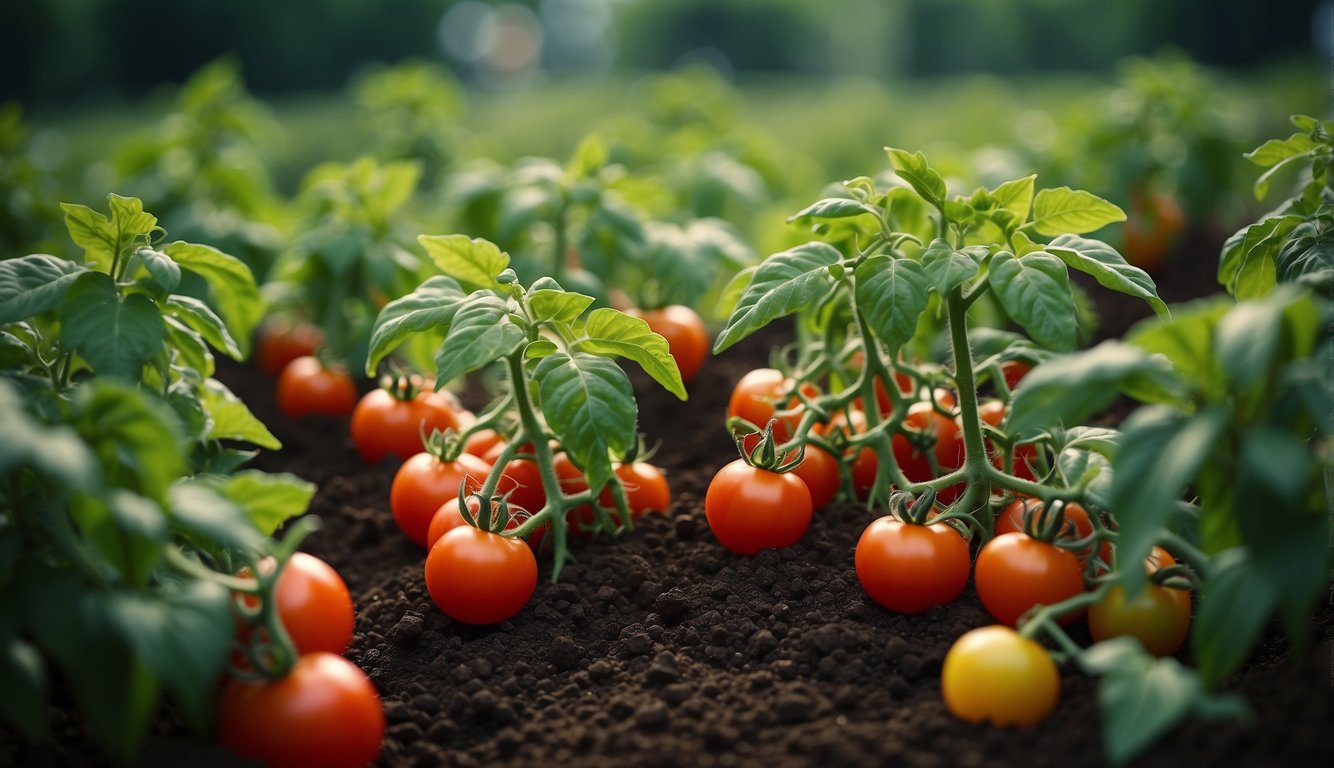TheHerbProf.com is a treasure trove of knowledge for those interested in natural healing and herbal remedies. The website is run by Paul Johnston MD. A naturopathic who has not only received extensive education in the field but also has personal experience in self-healing.
When it comes to growing tomatoes, one of the most important factors to consider is the type of fertilizer you use.
Fertilizer provides essential nutrients that tomato plants need to grow strong, healthy, and productive. However, with so many different types of fertilizers available, choosing the best one for your tomatoes can be a daunting task.
In this article, I will share my knowledge and expertise on the best fertilizer for tomatoes.
I will discuss the different types of fertilizers available, the nutrients that tomato plants need, and the best ways to apply fertilizer to your plants.
Whether you are a seasoned gardener or just starting out, this article will provide you with the information you need to grow healthy, vibrant tomato plants that produce a bountiful harvest.
Understanding Tomato Plant Nutrition – Best Fertilizer for Tomatoes
As a tomato gardener, it is important to understand the nutritional needs of your tomato plants.
Providing the right nutrients at the right time can help your plants grow strong and healthy, and produce a bountiful harvest.
Macronutrients and Micronutrients
Tomatoes, like all plants, require a combination of macronutrients and micronutrients to grow and thrive.
Macronutrients are nutrients that are required in larger quantities, while micronutrients are required in smaller quantities.
Macronutrients include nitrogen, phosphorus, and potassium, while micronutrients include calcium, magnesium, and various trace elements.
The Role of N-P-K in Tomato Growth – Best Fertilizer for Tomatoes
Nitrogen, phosphorus, and potassium, also known as N-P-K, are the three macronutrients that are most important for tomato growth.
Nitrogen is essential for vegetative growth and leaf production, while phosphorus is important for root growth and flower development.
Potassium is essential for overall plant health and helps to improve stress tolerance.
Identifying Nutrient Deficiencies
It is important to be able to identify nutrient deficiencies in your tomato plants so that you can take corrective action.
A nitrogen deficiency can cause yellowing leaves and stunted growth, while a phosphorus deficiency can cause a purple tint to the leaves and poor flowering.
A potassium deficiency can cause yellowing between the veins of older leaves and weak stems.
In addition to the macronutrients, micronutrient deficiencies can also occur and can cause a range of symptoms.
For example, a calcium deficiency can cause blossom end rot, while a magnesium deficiency can cause yellowing between the leaf veins.
Types of Fertilizers for Tomatoes – Best Fertilizer for Tomatoes
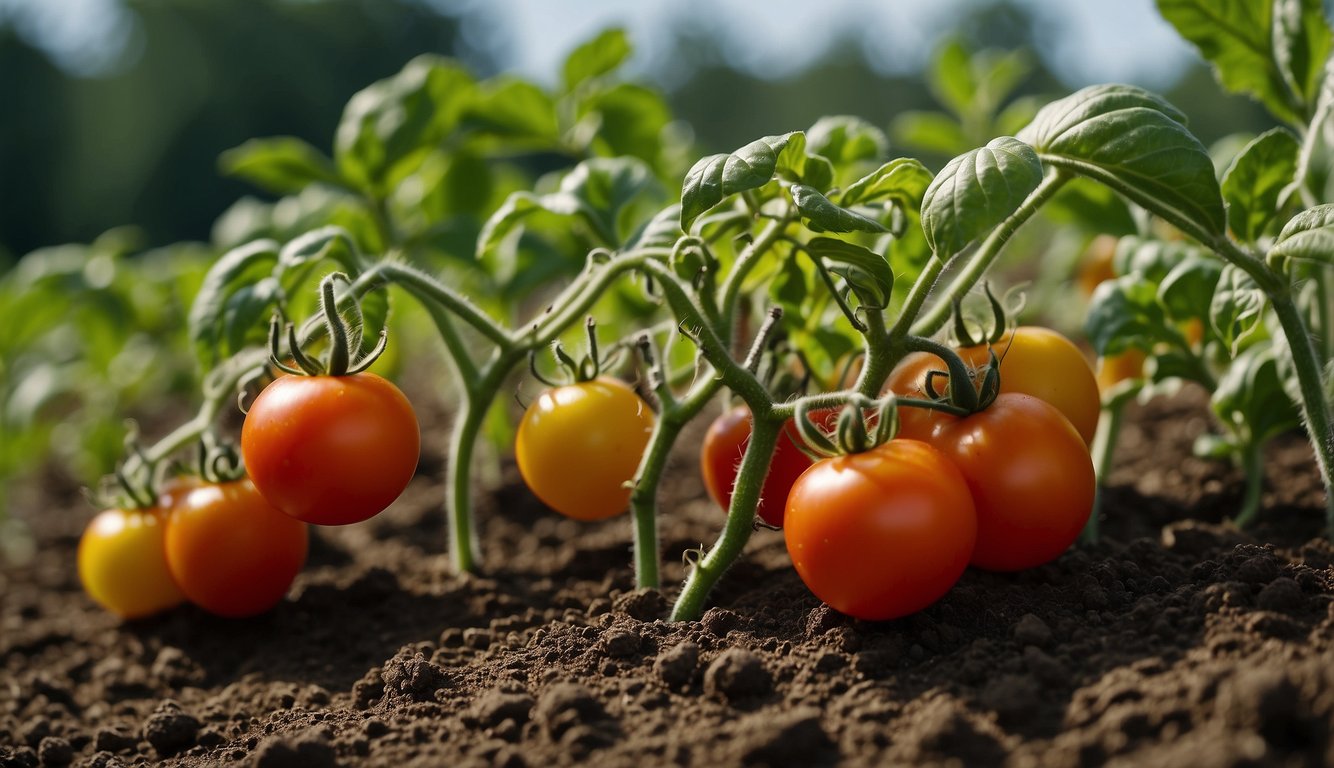
As a tomato grower, it’s essential to understand the different types of fertilizers available in the market.
Fertilizers provide the necessary nutrients required for the healthy growth of tomato plants. Here, I’ll discuss the various types of fertilizers for tomatoes.
Organic Versus Synthetic Fertilizers
Organic fertilizers are made from natural sources, such as animal manure, compost, and bone meal. They are an excellent choice for gardeners who prefer natural methods of farming.
Organic fertilizers are slow-release fertilizers that release nutrients gradually to the plants. They improve soil health and structure, making it easier for the plants to absorb nutrients.
On the other hand, synthetic fertilizers are made from chemical compounds. They are a quick-release fertilizer that provides nutrients to the plants immediately.
Synthetic fertilizers are easy to apply and are readily available in the market. However, they can harm the soil, and their overuse can lead to environmental pollution.
Slow-Release Versus Liquid Fertilizers – Best Fertilizer for Tomatoes
Slow-release fertilizers are a type of organic fertilizer that releases nutrients slowly over time.
They are less likely to burn the plants and are suitable for gardeners who prefer low-maintenance farming.
Slow-release fertilizers come in different forms, such as granules, pellets, and spikes, making it easier to apply.
Liquid fertilizers, on the other hand, are a type of synthetic fertilizer that provides nutrients to the plants immediately.
They are easy to apply and are suitable for gardeners who prefer high-maintenance farming.
Liquid fertilizers come in different forms, such as powder, concentrate, and spray, making it easier to apply.
Specialized Tomato Fertilizers
Tomato fertilizers are specialized fertilizers that are designed explicitly for tomato plants.
They are formulated to provide the necessary nutrients required for the healthy growth of tomato plants.
Tomato fertilizers come in different forms, such as granules, pellets, and spikes.
Preparing Soil for Tomato Plants – Best Fertilizer for Tomatoes
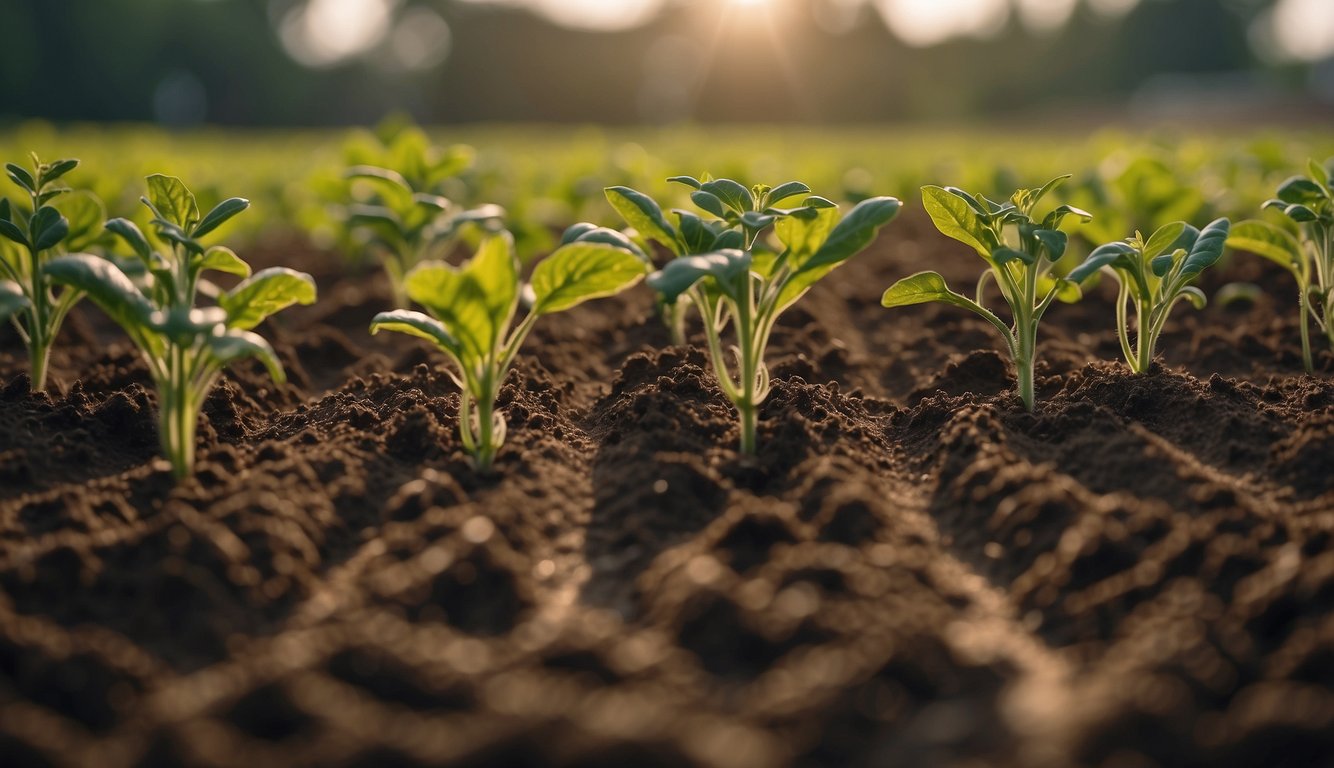
As a tomato plant enthusiast, I know that growing healthy and juicy tomatoes requires proper soil preparation. In this section, I will take you through the essential steps to prepare your soil for tomato plants.
Conducting a Soil Test
Before planting your tomato seedlings, it is essential to conduct a soil test to determine the pH level of your garden.
Tomatoes grow best in slightly acidic soil with a pH level between 6.0 and 7.0. You can use a soil test kit or take a sample of your soil to a local laboratory for testing.
Adjusting Soil pH
If the pH level of your soil is too high (over 7.0), you need to add sulfur to lower the pH level.
On the other hand, if the pH level is too low (below 6.0), you need to add lime to raise the pH level.
You can use a pH meter or pH strips to monitor the pH level of your soil.
Enhancing Soil Structure with Organic Matter – Best Fertilizer for Tomatoes
Apart from the pH level, the ideal soil type for tomatoes should be well-draining and loose. To achieve this, you can add organic matter to your soil.
Nutrient-packed compost is the best way to improve any type of garden soil—from heavy clay to fast-draining sand. Compost supplies elements tomato plants need to produce healthy foliage and flavorful fruits.
Another way to enhance soil structure is by adding well-rotted manure.
Manure is rich in nutrients and can help improve soil fertility. However, it is important to use well-rotted manure to avoid burning your plants with excess nitrogen.
Best Practices for Fertilizing Tomatoes – Best Fertilizer for Tomatoes
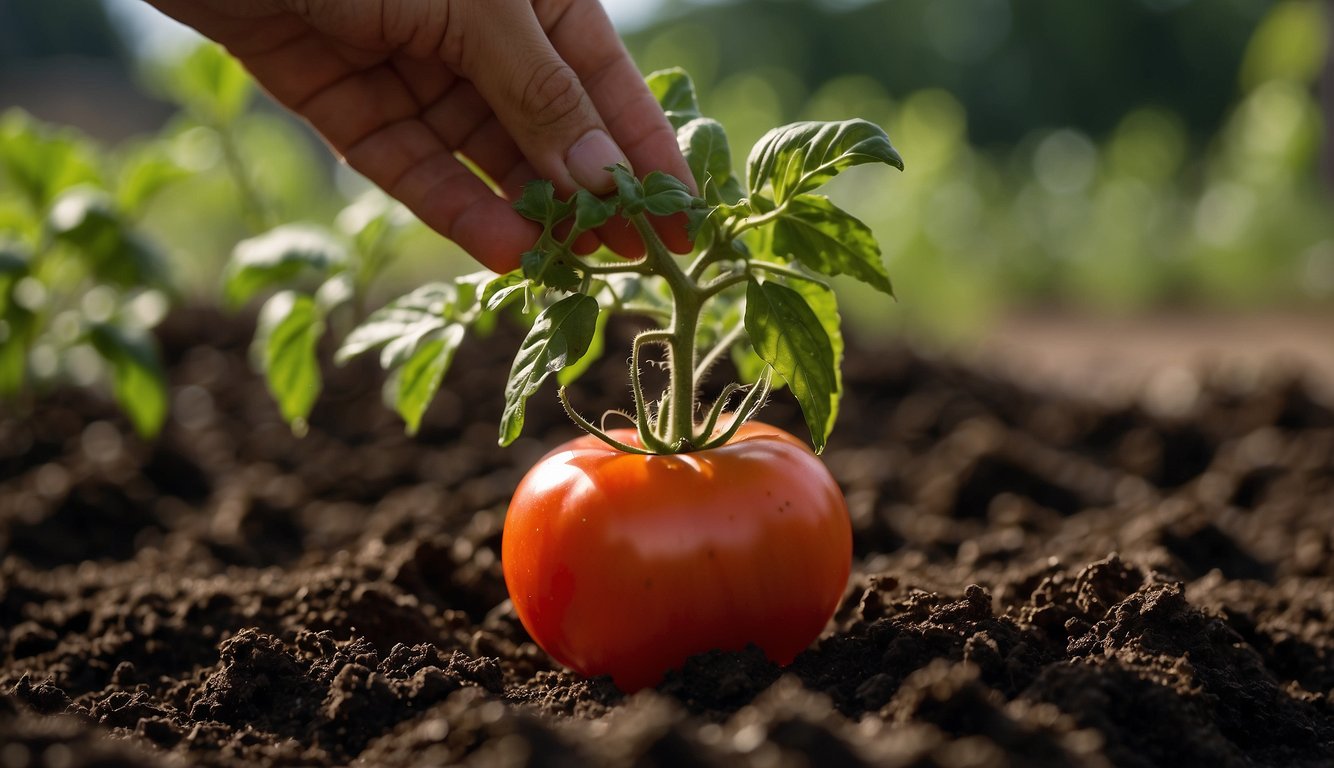
As a seasoned gardener, I have learned that proper fertilization is crucial for growing healthy and productive tomato plants. In this section, I will share some best practices for fertilizing tomatoes that will help you achieve the best results.
When to Fertilize Tomato Seedlings
Tomato seedlings require proper nutrition to grow into healthy plants.
I recommend fertilizing tomato seedlings with a balanced fertilizer, such as a 10-10-10, at the time of planting.
This will provide the necessary nutrients for the young plants to establish their root system and start growing.
Fertilization Frequency During the Growing Season
Once the tomato plants have established their roots, it’s time to fertilize them regularly throughout the growing season.
I recommend fertilizing tomato plants every two to three weeks during the growing season.
Nitrogen-rich fertilizers, such as fish emulsion or blood meal, can be added every two weeks to promote healthy foliage growth.
As the plants start to set fruit, switch to a fertilizer with a higher phosphorus content, such as a 5-10-5 or 10-20-10, to promote flower and fruit development.
Application Rates and Methods – Best Fertilizer for Tomatoes
It’s important to apply the right amount of fertilizer to avoid over-fertilization, which can lead to plant damage or even death.
I recommend following the manufacturer’s instructions for the specific fertilizer you are using.
Generally, you should apply one to two pounds of fertilizer per 100 square feet of garden space.
When applying the fertilizer, make sure to spread it evenly around the base of the plant, keeping it at least six inches away from the stem to avoid burning the plant.
You can also mix the fertilizer into the soil around the plant and water it in thoroughly.
Common Issues with Tomato Fertilization – Best Fertilizer for Tomatoes
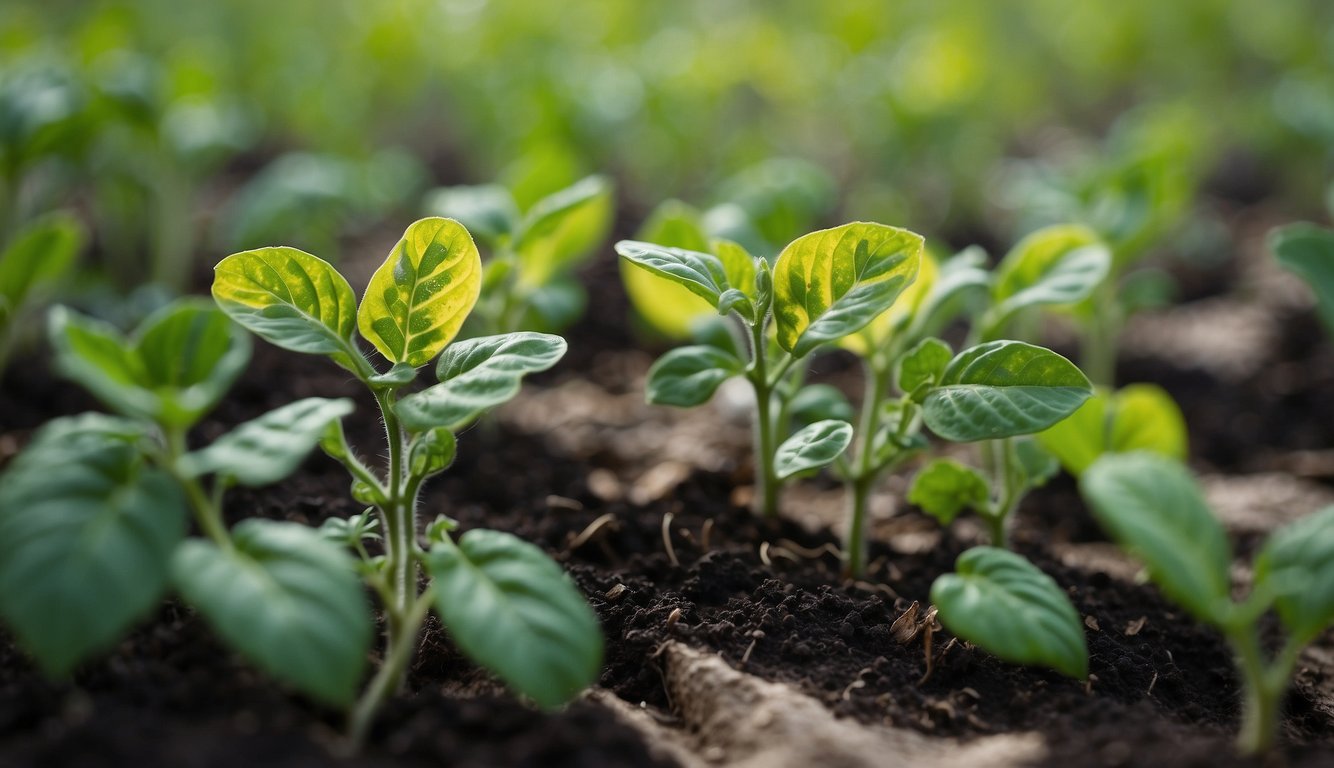
As with any gardening practice, there are some common issues that can arise when fertilizing tomato plants. Here are some of the most common issues and how to avoid or deal with them.
Avoiding Over-Fertilization
Over-fertilization can be a real problem when it comes to growing healthy tomato plants.
Too much fertilizer can lead to a buildup of salts in the soil, which can cause root damage and even plant death. Additionally, excess nitrogen can lead to lush, green foliage at the expense of fruit production.
To avoid over-fertilization, it’s important to follow the instructions on the fertilizer package carefully.
Don’t be tempted to use more fertilizer than recommended, as this can do more harm than good.
If you’re unsure about how much fertilizer to use, consult a gardening expert or do some research online.
Dealing with Blossom End Rot – Best Fertilizer for Tomatoes
Blossom end rot is a common problem that can occur when tomato plants are not getting enough calcium.
This can be caused by a number of factors, including uneven watering, pH imbalances, and a lack of calcium in the soil.
To prevent blossom end rot, it’s important to maintain consistent watering and ensure that the soil pH is within the correct range.
Additionally, adding calcium-rich amendments to the soil, such as crushed eggshells or bone meal, can help prevent calcium deficiency.
Preventing Stunted Growth
Stunted growth in tomato plants can be caused by a number of factors, including poor soil quality, a lack of nutrients, and disease.
In some cases, stunted growth can also be caused by a phosphorus deficiency.
To prevent stunted growth, it’s important to ensure that your tomato plants are getting enough nutrients, including phosphorus.
Adding a phosphorus-rich fertilizer to the soil can help promote healthy growth and development.
Additionally, maintaining good soil quality and preventing disease can also help prevent stunted growth in tomato plants.
Additional Tips for Tomato Plant Care – Best Fertilizer for Tomatoes
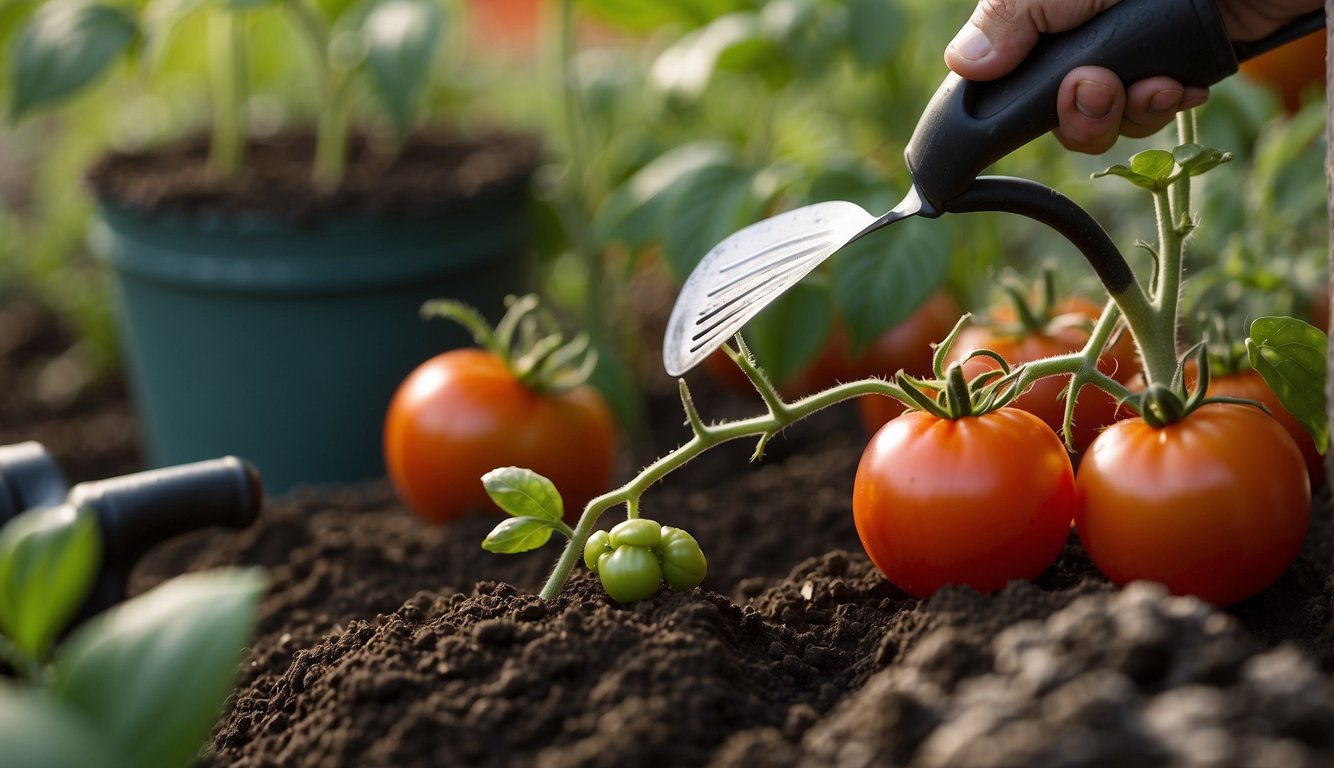
Watering and Fertilizer Interaction
Watering and fertilizing tomato plants go hand in hand.
It is important to water your plants regularly to ensure that the soil is moist and the nutrients are available to the plant.
It is recommended to water your plants deeply once or twice a week, depending on the weather conditions.
Avoid overwatering your plants as it can lead to root rot and other diseases.
When fertilizing your tomato plants, it is important to keep in mind the interaction between water and fertilizer.
Water-soluble fertilizers can easily be washed away by excessive watering, leading to nutrient deficiency in the plants.
To avoid this, it is recommended to apply water-soluble fertilizers on moist soil and then water the plants immediately after application.
This will help the nutrients to penetrate the soil and reach the roots of the plant.
Using Compost and Compost Tea
Compost is a great source of organic matter and nutrients for tomato plants.
It is rich in nitrogen, phosphorus, and potassium, which are essential for the growth and development of the plant.
Adding compost to the soil can help improve soil structure, increase water retention, and promote healthy root growth.
Compost tea is another great way to provide your tomato plants with essential nutrients.
It is made by steeping compost in water and then using the resulting liquid to water your plants.
Compost tea is rich in beneficial microorganisms, which can help improve soil health and protect your plants from diseases.
Incorporating Amendments like Bone Meal and Epsom Salt
In addition to compost, you can also incorporate other amendments like bone meal and Epsom salt to provide your tomato plants with essential nutrients.
Bone meal is a great source of phosphorus, which is important for root development and fruit production.
Epsom salt is rich in magnesium, which is important for chlorophyll production and overall plant health.
When incorporating amendments, make sure to follow the recommended application rates to avoid overfertilization, which can lead to nutrient burn and other problems.
It is also important to mix the amendments thoroughly into the soil to ensure that the nutrients are evenly distributed.
Enhancing Tomato Quality and Yield – Best Fertilizer for Tomatoes
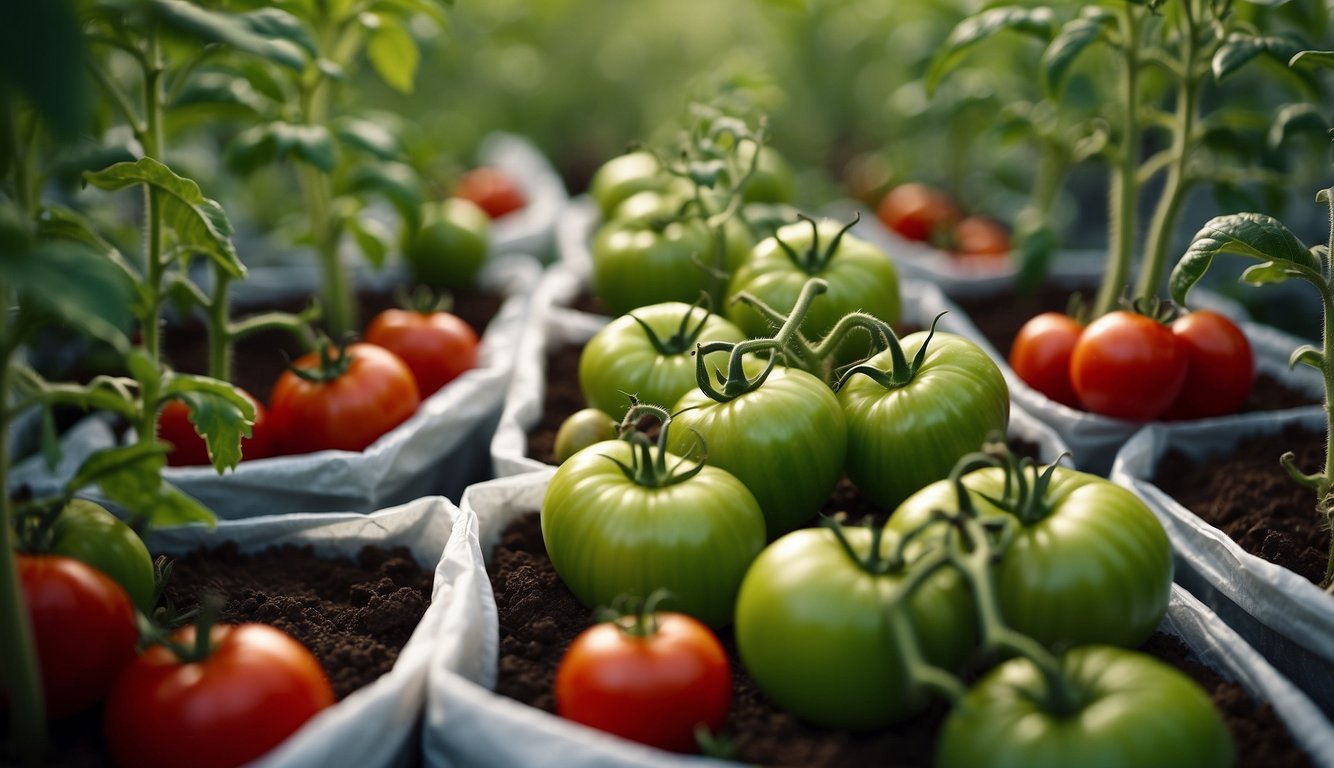
Fertilizer’s Impact on Fruit Development
As a tomato plant grows, it will begin to produce flowers which will eventually turn into fruits.
To ensure that these fruits are of high quality and yield, it is important to provide the plant with the right nutrients at the right time.
Nitrogen, phosphorus, and potassium are the three main macronutrients that are essential for plant growth and development.
Nitrogen is important for leaf and stem growth, while phosphorus is important for root development and fruiting.
Potassium is important for overall plant health and helps to regulate water balance.
Improving Fruit Quality and Flavor – Best Fertilizer for Tomatoes
To improve the quality and flavor of tomatoes, it is important to provide the plant with the right balance of nutrients.
While nitrogen is important for plant growth, too much nitrogen can result in excessive leaf and stem growth at the expense of fruit development.
On the other hand, a lack of nitrogen can result in stunted growth and poor fruit development.
Phosphorus is important for fruit development and can help to improve the size and quality of the fruit.
Potassium is also important for fruit quality and can help to improve the flavor of the fruit.
Encouraging Healthy Root and Foliage Growth
In addition to providing the plant with the right balance of nutrients, it is also important to encourage healthy root and foliage growth.
A healthy root system is essential for nutrient uptake and water absorption, while healthy foliage is important for photosynthesis and overall plant health.
To encourage healthy root growth, make sure to provide the plant with phosphorus.
To encourage healthy foliage growth, make sure to provide the plant with nitrogen.
Potassium is also important for overall plant health and can help to improve the plant’s resistance to disease and pests.
Special Considerations for Different Growing Conditions
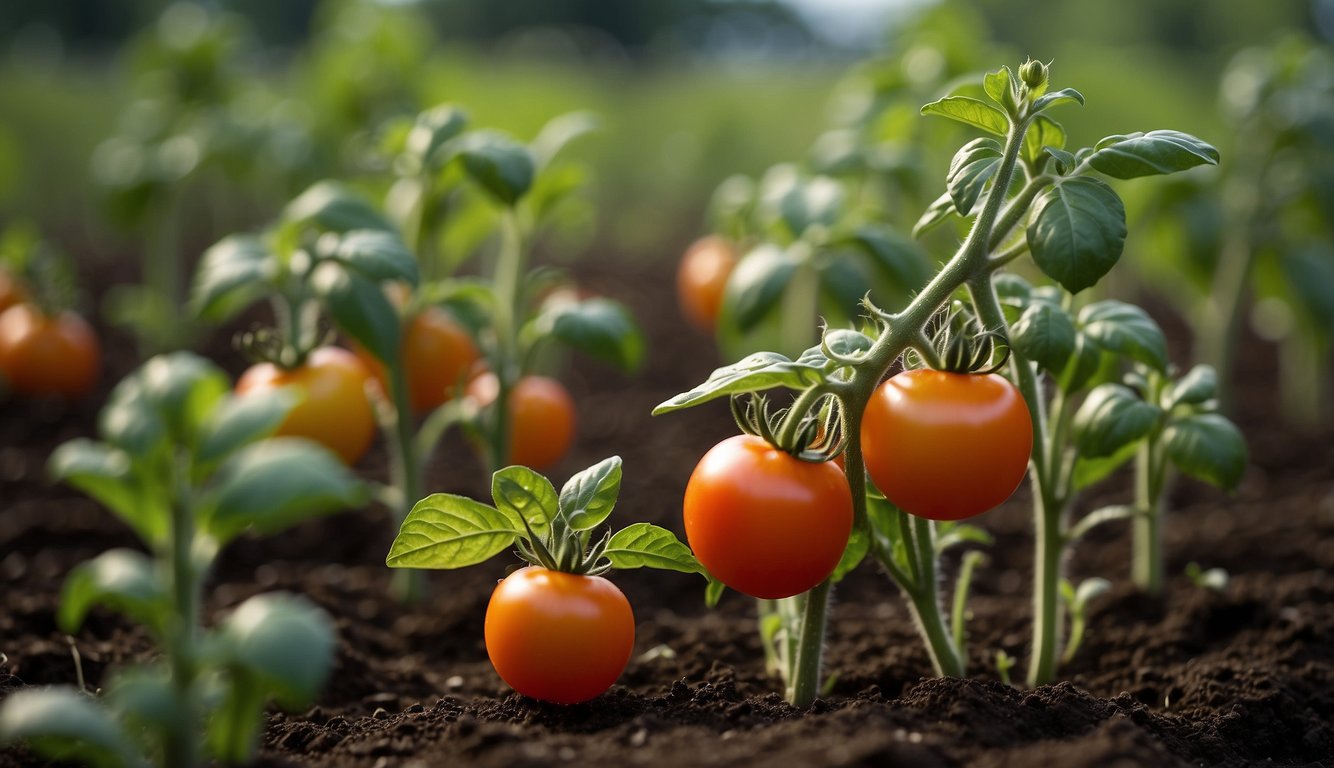
Fertilizing Tomatoes in Containers
When growing tomatoes in containers, it’s important to choose the right type of fertilizer.
Container-grown tomatoes require a balanced fertilizer with equal parts of nitrogen, phosphorus, and potassium.
The fertilizer should also contain micronutrients such as calcium, magnesium, and iron.
I recommend using a slow-release fertilizer that will provide a steady supply of nutrients to the plants over time.
It’s also important to monitor the soil moisture levels in container gardens.
The soil in containers can dry out quickly, especially during hot weather.
If the soil becomes too dry, the plants may not be able to absorb nutrients from the fertilizer.
I recommend watering container-grown tomatoes regularly and checking the soil moisture levels frequently.
Ground Planting Versus Raised Beds
When planting tomatoes in the ground, it’s important to choose the right type of fertilizer based on the soil type.
Sandy soils require more frequent fertilization than clay soils.
Raised beds are a popular option for growing tomatoes because they provide better drainage and aeration than traditional in-ground gardens.
When fertilizing tomatoes in raised beds, it’s important to choose a fertilizer that is specifically formulated for raised beds.
These fertilizers are designed to provide the right balance of nutrients for plants grown in raised beds.
Adjusting Fertilization for Tomato Varieties
Different tomato varieties have different nutrient requirements.
Determinate tomatoes, for example, are a compact variety that requires less fertilizer than indeterminate varieties.
I recommend using a fertilizer with a lower nitrogen content for determinate tomatoes.
Indeterminate tomatoes, on the other hand, require more fertilizer because they continue to grow and produce fruit throughout the growing season.
I recommend using a fertilizer with a higher nitrogen content for indeterminate tomatoes.
It’s also important to consider the ripening time of the tomato variety when choosing a fertilizer.
Early ripening varieties require less fertilizer than late ripening varieties.
I recommend using a fertilizer with a lower nitrogen content for early ripening varieties.
Bridging Best Fertilizer for Tomatoes with TheHerbProf
Let’s explore how our Best Fertilizer for Tomatoes and the herbal goldmine at theherbprof.com can work together.
Our Best Fertilizer for Tomatoes is a game-changer for your tomato plants. It provides all the nutrients they crave. But what about the rest of their care? That’s where theherbprof.com comes in. It’s your one-stop-shop for all things herbal, including tomato care!
Imagine this. You’ve used our Best Fertilizer for Tomatoes and your plants are thriving. But you’re wondering about pruning or pest control. No worries! Theherbprof.com has all the answers. It offers a wealth of information on how to care for your tomato plants.
And there’s more! Theherbprof.com also shares the health benefits of tomatoes. So, while you’re enjoying the fruits of your labor, you’re also learning about their nutritional value.
So, let’s get growing with our Best Fertilizer for Tomatoes and let theherbprof.com guide us on this tomato-growing journey.
References – Best Fertilizer for Tomatoes
Little Herb Encyclopedia, by Jack Ritchason; N.D., Woodland Publishing Incorporated, 1995
The Ultimate Healing System, Course Manual, Copyright 1985, Don Lepore
Planetary Herbology, Michael Tierra, C.A., N.D., Lotus Press, 1988
Handbook of Medicinal Herbs, by James A. Duke, Pub. CRP Second Edition 2007
The Complete Medicinal Herbal, by Penelope Ody, Published by Dorling Kindersley
Check the Following Articles!
Best Vegetables to Grow in Partial Shade?
Top Pruning Shears for a Clean and Precise Cut
Seed Starter Recipe: How to Make Your Own at Home
Most Beautiful Fruit Trees: Stunning Trees for Your Garden
Frequently Asked Questions – Best Fertilizer for Tomatoes
What type of homemade fertilizer can I use for my tomato plants?
Homemade fertilizers are a great way to provide nitrogen, phosphorous, potassium, and other nutrients for your tomato plants.
You can use compost, manure, bone meal, or fish emulsion as a natural fertilizer.
The Gardening Dad suggests using a homemade compost tea that is rich in nutrients and easy to make.
What is the ideal NPK ratio for fertilizing tomatoes?
The ideal NPK (nitrogen, phosphorous, potassium) ratio for fertilizing tomatoes is 5-10-10 or 10-20-10.
Tomato About recommends using a balanced organic fertilizer with equal parts of nitrogen, phosphorus, and potassium (10-10-10) for the first 2-3 weeks after transplanting. Then, switch to a fertilizer higher in phosphorus and potassium as the plants start heavy fruiting.
How often should I fertilize my tomato plants throughout the growing season?
Fertilizing frequency depends on the type of fertilizer you are using and the growth stage of your tomato plants.
The Spruce suggests using a nitrogen-rich fish emulsion every two weeks and blood meal every six weeks during the growing season.
You can side-dress each plant with 1/2 to 1 tablespoon of balanced organic fertilizer every 2-3 weeks, increasing amounts to 2-3 tbsp per plant.
Can I use a balanced 20-20-20 fertilizer for my tomato plants, and what are the implications?
While a balanced 20-20-20 fertilizer can be used for tomato plants, it is not recommended.
Tomato Dirt explains that high nitrogen levels in a 20-20-20 fertilizer can lead to excessive foliage growth and delay fruiting.
It is better to use a fertilizer with a higher phosphorus and potassium content for better fruit development.
What are the best fertilization practices for growing tomatoes in containers?
Growing tomatoes in containers requires careful fertilization practices to avoid over-fertilizing or under-fertilizing the plants.
Sow Right Seeds recommends using a slow-release fertilizer or a water-soluble fertilizer with a lower nitrogen content to prevent root burn.
You can also use a liquid fertilizer every 2-3 weeks during the growing season.
Are there any special fertilizers or ingredients recommended for achieving the best tomato growth?
To achieve the best tomato growth, you can use fertilizers with added calcium or magnesium to prevent blossom end rot, a common tomato plant disease.
The Gardening Dad recommends using a fertilizer with added humic acid to improve soil structure and nutrient uptake.
Additionally, using an organic fertilizer can improve soil health and provide long-term benefits for your tomato plants.
